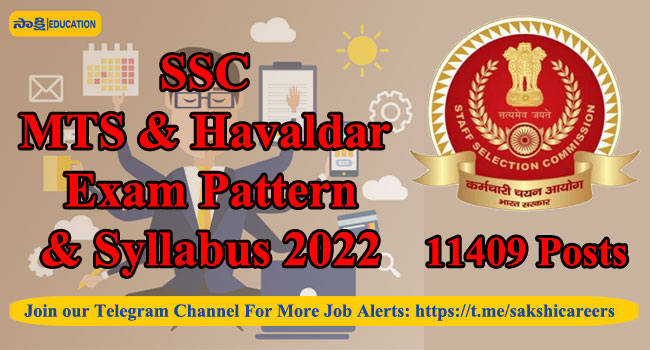SSC MTS & Havaldar Exam Pattern & Syllabus 2022; Check Notification Here!!

Scheme of Examination:
The examination will consist of a Computer Based Examination, Physical Efficiency Test (PET)/ Physical Standard Test (PST) (only for the post of Havaldar).
Computer Based Examination will be conducted in two Sessions: Session-I and Session-II and both the Sessions will be mandatory to be attempted. Not attempting any session will disqualify the candidate.
11409 Vacancies for 10th pass at SSC (MTS Notification)
SSC MTS & Havaldar Computer Based Examination 2022:
|
Part |
Subject |
Number of Questions/ Maximum Marks |
Duration |
|
Session-I |
45 Minutes |
||
|
I |
Numerical and Mathematical Ability |
20/60 |
|
|
II |
Reasoning Ability and Problem Solving |
20/60 |
|
|
Session-II |
45 Minutes |
||
|
I |
General Awareness |
25/75 |
|
|
II |
English Language and Comprehension |
25/75 |
|
Note: There will be no negative marking in Session-I. In Session-II, there will be negative marking of one mark for each wrong answer. Candidates are, therefore, advised to keep this in mind while answering the questions
SSC MTS & Havaldar Indicative Syllabus for Computer Based Examination:
Numerical and Mathematical Ability: It will include questions on problems relating to Integers and Whole Numbers, LCM and HCF, Decimals and Fractions, Relationship between numbers, Fundamental Arithmetic Operations and BODMAS, Percentage, Ratio and Proportions, Work and Time, Direct and inverse Proportions, Averages, Simple Interest, Profit and Loss, Discount, Area and Perimeter of Basic Geometric Figures, Distance and Time, Lines and Angles, Interpretation of simple Graphs and Data, Square and Square roots etc.
Reasoning Ability and Problem Solving: The questions in this part intend to measure the candidates’ general learning ability. The questions will be broadly based on Alpha-Numeric Series, Coding and Decoding, Analogy, Following Directions, Similarities and Differences, Jumbling, Problem Solving and Analysis, Nonverbal Reasoning based on diagrams, age Calculations, Calendar and Clock, etc.
General Awareness: The broad coverage of the test will be on Social Studies (History, Geography, Art and Culture, Civics, Economics), General Science and Environmental studies up to 10th Standard.
English Language and Comprehension: Candidates' understanding of the basics of English Language, its vocabulary, grammar, sentence structure, synonyms, antonyms and its correct usage, etc. and to test comprehension, a simple paragraph may be given and question based on the paragraph to be asked.
For VH candidates of 40% and above visual disability, there will be no component of Maps/Graphs/Diagrams/Statistical Data in the Paper.
Physical Efficiency Test (PET)/ Physical Standard Test (PST) for the post of Havaldar in CBIC and CBN: Followings are the PET/ PST standards for the post of Havaldar in CBIC and CBN:
Physical Efficiency Test (PET):
|
|
Male |
Male |
|
Walking |
1600 meters in 15 minutes. |
1 Km in 20 minutes |
Physical Standard Test (PST): The minimum physical standards for the post of Havaldar in CBIC and CBN are as follows:
Male:
|
Height |
Chest |
|
157.5 cms. (relaxable by 5 cms. in the case of Garhwalis, Assamese, Gorkhas and members of Schedule Tribes) |
Chest-81 cms. (fully expanded with minimum expansion of 5 cms.) |
Female:
|
Height |
Chest |
|
152 cms. relaxable by 2.5 Cms in the case of Garhwalis, Assamese, Gorkhas and members of Schedule Tribes) |
48 kg (relaxable by 2 Kg in the case of Garhwalis, Assamese, Gorkhas and members of Schedule Tribes) |
PET/ PST will be conducted by CBIC/ CBN at various centres finalized by them. The candidates may be called for PET/ PST to any centre across the country.







